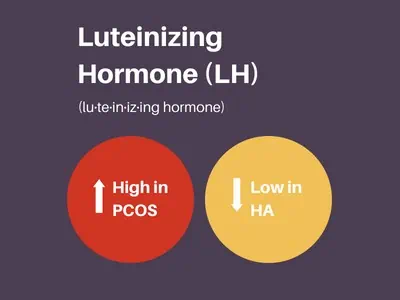
What is the difference between polycystic ovary syndrome (PCOS) and hypothalamic amenorrhea?
PCOS is the condition of androgen excess when all other causes of androgen excess have been ruled out. It’s often associated with irregular periods or no periods.
Hypothalamic amenorrhea (HA) is irregular periods (or no periods) due to undereating or other stressors. It can also present with mild acne, facial hair, and polycystic ovaries.
The two conditions are similar, so your doctor might have mistakenly said you have PCOS when you actually have hypothalamic amenorrhea.
Is it PCOS or hypothalamic amenorrhea?
Here’s a summary of the similarities and differences.
| PCOS | Hypothalamic amenorrhea |
|---|---|
| absent or irregular cycles | absent or irregular cycles |
| polycystic ovaries | polycystic ovaries |
| hirsutism and elevated androgens | possible mild hirsutism |
| normal or high fasting insulin | low fasting insulin |
| thickened uterine lining | thin uterine lining |
| bleed from progesterone challenge | no bleed from progesterone challenge |
| mild risk of bone loss | significant bone loss |
| few periods when first stopping the pill | no periods when stopping the pill |
| any age but can outgrow it | more likely under 30, but any age |
| high LH to FSH ratio | low LH to FSH ratio |
Do you notice that polycystic ovaries can occur with both PCOS and hypothalamic amenorrhea? That’s why PCOS cannot be diagnosed by ultrasound. In fact, relying on an ultrasound can result in hypothalamic amenorrhea being misdiagnosed as lean PCOS. And that’s a problem because the treatment for PCOS is to eat less, while the treatment for hypothalamic amenorrhea is to eat more!
The simplest way to distinguish between PCOS and hypothalamic amenorrhea is to look at the ratio between luteinizing hormone (LH) and follicle-stimulating hormone (FSH). When measured on day 2 of the cycle (or random day if there is no cycle), the LH to FSH ratio is high in PCOS and low in hypothalamic amenorrhea. LH increases with age so there is no “perfect” value for LH. What matters is how high or low it is compared to FSH.

3 steps to diagnose PCOS
Step 1. Are there signs of high androgens or male hormones? For example, are there high androgens on a blood test, or symptoms of androgens such as hirsutism or facial hair? If not, it’s not PCOS because PCOS is the condition of androgen excess when all other causes of androgen excess have been ruled out.
Step 2. Have other causes of excess androgens been ruled out? One common cause of androgen excess is congenital adrenal hyperplasia, which accounts for up to 9 percent of cases of androgen excess and is frequently misdiagnosed as PCOS.
Step 3. Determine the type of PCOS and treat the main underlying driver. Read 4 types of PCOS (a flowchart).
Ask me in the comments.
